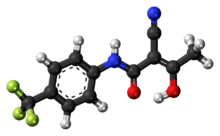Teriflunomide
 | |
 | |
| Clinical data | |
|---|---|
| Trade names | Aubagio |
| Synonyms | A77 1726 |
| License data |
|
| Pregnancy category |
|
| Routes of administration | Oral (tablets) |
| ATC code | |
| Legal status | |
| Legal status |
|
| Pharmacokinetic data | |
| Protein binding | >99.3% |
| Biological half-life | 2 weeks |
| Excretion | Biliary/fecal, renal |
| Identifiers | |
| |
| CAS Number | |
| PubChem CID | |
| IUPHAR/BPS | |
| ChemSpider | |
| UNII | |
| KEGG | |
| ChEBI | |
| ChEMBL | |
| ECHA InfoCard | 100.170.077 |
| Chemical and physical data | |
| Formula | C12H9F3N2O2 |
| Molar mass | 270.207 g/mol |
| 3D model (JSmol) | |
| |
| |
| | |
Teriflunomide (trade name Aubagio, marketed by Sanofi) is the active metabolite of leflunomide.[1] Teriflunomide was investigated in the Phase III clinical trial TEMSO as a medication for multiple sclerosis (MS). The study was completed in July 2010.[2] 2-year results were positive.[3] However, the subsequent TENERE head-to-head comparison trial reported that "although permanent discontinuations [of therapy] were substantially less common among MS patients who received teriflunomide compared with interferon beta-1a, relapses were more common with teriflunomide."[4] The drug was approved by the FDA on September 13, 2012[5] and in the European Union on August 26, 2013.[6]
Mechanisms of action
Teriflunomide is an immunomodulatory drug inhibiting pyrimidine de novo synthesis by blocking the enzyme dihydroorotate dehydrogenase. It is uncertain whether this explains its effect on MS lesions.[7]
Teriflunomide inhibits rapidly dividing cells, including activated T cells, which are thought to drive the disease process in MS. Teriflunomide may decrease the risk of infections compared to chemotherapy-like drugs because of its more-limited effects on the immune system.[8]
It has been found that teriflunomide blocks the transcription factor NF-κB. It also inhibits tyrosine kinase enzymes, but only in high doses not clinically used.[9]
Activation of leflunomide to teriflunomide
The branded drug teriflunomide is the main active in vivo metabolite of the generically available leflunomide. Upon administration of leflunomide, 70% of the drug administered converts into teriflunomide. The only difference between the molecules is the opening of the isoxazole ring. This is considered a simple structural modification and a technically simple one-step synthetic transformation. Upon oral administration of leflunomide in vivo, the isoxazole ring of leflunomide is opened and teriflunomide is formed.[10]

"Regardless of the substance administered (leflunomide or teriflunomide), it is the same molecule (teriflunomide)—the one exerting the pharmacological, immunological or metabolic action in view of restoring, correcting or modifying physiological functions, and does not present, in clinical use, a new chemical entity to patients."[10] Because of this, EMA initially had not considered teriflunomide being a new active substance.[13]
See also
See leflunomide for information on pharmacokinetics, side effects, contraindications and other data.
References
- ↑ Magne D, Mézin F, Palmer G, Guerne PA (2006). "The active metabolite of leflunomide, A77 1726, increases proliferation of human synovial fibroblasts in presence of IL-1beta and TNF-alpha". Inflamm. Res. 55 (11): 469–75. PMID 17122964. doi:10.1007/s00011-006-5196-x.
- ↑ ClinicalTrials.gov Phase III Study of Teriflunomide in Reducing the Frequency of Relapses and Accumulation of Disability in Patients With Multiple Sclerosis (TEMSO)
- ↑ "Sanofi-Aventis’ Teriflunomide Comes Up Trumps in Two-Year Phase III MS Trial". 15 Oct 2010.
- ↑ Gever, John (June 4, 2012). "Teriflunomide Modest Help but Safe for MS" (Report Author: Vermersch, Pstrick). medpage. Joint meeting of the Consortium of Multiple Sclerosis Centers and the Americas Committee for Treatment and Research in Multiple Sclerosis. Retrieved June 4, 2012.
- ↑ "FDA approves new multiple sclerosis treatment Aubagio" (Press release). US FDA. Retrieved 2012-09-14.
- ↑ EU authorisation details, EMA, retrieved 2014-04-29
- ↑ H. Spreitzer (March 13, 2006). "Neue Wirkstoffe - Teriflunomid". Österreichische Apothekerzeitung (in German) (6/2006).
- ↑ Timothy Vollmer (May 28, 2009). "MS Therapies in the Pipeline: Teriflunomide". EMS News (May 28, 2009).
- ↑ Breedveld, FC; Dayer, J-M (November 2000). "Leflunomide: mode of action in the treatment of rheumatoid arthritis". Ann Rheum Dis. 59 (11): 841–849. PMC 1753034
 . PMID 11053058. doi:10.1136/ard.59.11.841.
. PMID 11053058. doi:10.1136/ard.59.11.841. - 1 2 Melchiorri, Daniela; Barbara, van Zwieten-Boot; Romaldas, Maciulaitis; Nela, Vilceanu; Karsten, Bruins Slot; Ian, Hudson; Robert, Hemmings; Harald, Enzmann; Pierre, Demolis. "Assessment report. AUBAGIO (international non-proprietary name: teriflunomide). Procedure No. EMEA/H/C/002514/0000" (PDF). European Medicines Agency. European Medicines Agency. p. 119. Retrieved 5 June 2015.
- ↑ Rozman, B (2002). "Clinical Pharmacokinetics of Leflunomide.". Clinical pharmacokinetics. 41 (6): 421–30. PMID 12074690. doi:10.2165/00003088-200241060-00003.
- ↑ "Clinical Pharmacology/Biopharmaceutics Review. Product: ARAVA (leflunomide tablets). Application Number: NDA 20905" (PDF). U.S. Food and Drug Administration. Center for Drug Evaluation and Research. Retrieved 15 April 2016.
- ↑ "Summary of Opinion (Initial Authorisation): Aubagio (teriflunomide)" (PDF). European Medicines Agency. Retrieved 15 April 2016.
External links
- AUBAGIO® (teriflunomide) 14 mg tablets — Aubagio website